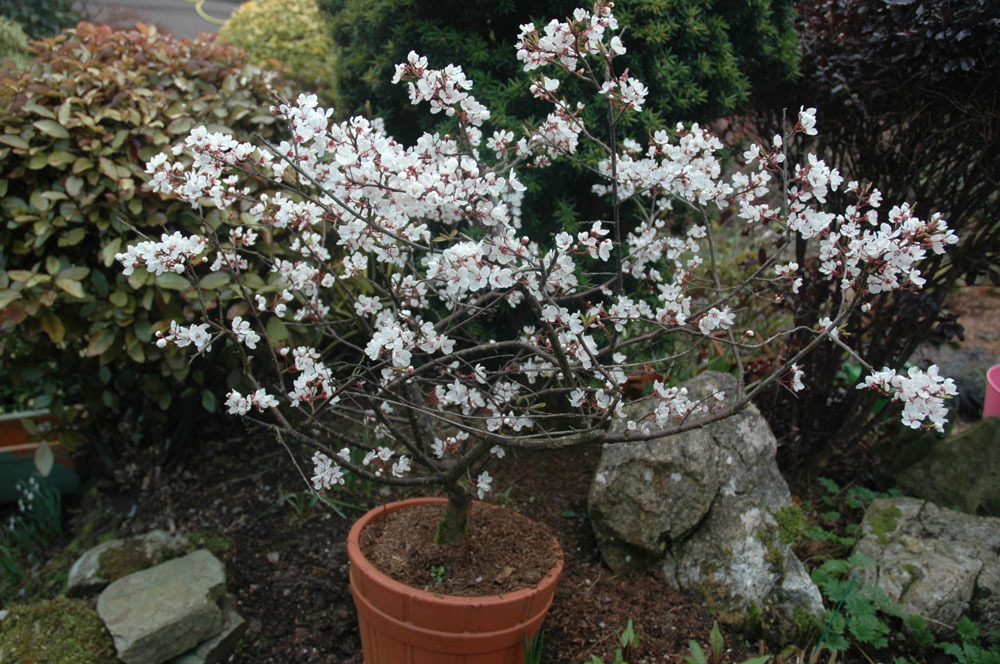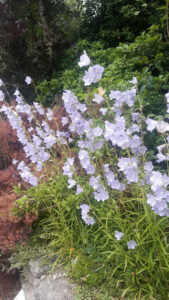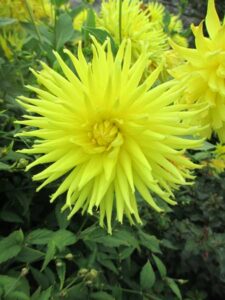Gardening
with Charlie Wilkins
THE WINSOME CHERRY
No flower is as mysteriously winsome as the cherry, but then spring flowers have always touched a soft streak in human nature! I have never been to Japan but if I were there now, the plum, peach, and cherry trees would be flowering (in succession) even though bitter winds and vicious scuds of snow often mingle with the delicate petals. The East’s spectacular season of blossom begins in early March as the plum tree buds unfurl and step into centre-stage limelight. Their beauty is cursory and despite their allure it fills the heart of Easterners with sadness so short is their peak of perfection. Thereafter comes the season of peach blossom, followed in turn by the cherry which in China and Japan commands the highest admiration and affection. In both countries expeditions to the mountains are organised so that city workers can observe this spectacular spring phenomenon first-hand. Travel brochures reveal tit-bit chocolates of information about these cherry-time celebrations, and many tell of informal tea stalls opened for visitors (serving the equivalent of our ‘queen cakes’) presented with green tea on bamboo tables whilst paper lanterns (suitably decorated with cherry drawings) float away on the evening breeze. It must be spectacular and I would love to see it!
Compared to the veneration of blossoms shown in these far-flung countries our view of cherry trees is rather dismal. We have used the variety ‘Kanzan’ (in particular) as street ‘furniture’ in Ballyphehane and these live out their dusty, traffic-fumed lives in suburbia devoid of proper attention and refinement. Their rather gangling habits bore us and their colours we exclaim, are far too garish. It’s hardly their fault however, for there was no real thought or advice ever given about their positioning or needs, and for our sins they are now seen much the same in their vices and virtues; one superb show of flower (if the weather holds) then dullness for the remainder of the summer. The planners I know, failed to choose the better forms!
There is a neglected group of cherries that are much more biddable than ‘Kanzan’ and their ilk. Where garden space is limited Prunus incisa should be the cherry of choice. Its blossom comes early, the autumn colour is spectacular and even the leaves are interesting. Incisa never grows very large which means that it will take kindly to pot culture and in the open garden. More often than not, this particular cherry is found as a shrub rather than a small tree. The small potted specimen that I grow is easy to maintain and it flowers profusely (in a sheltered spot I must admit) for the garden is high and often windswept). For all that, I lavish it with my most abundant commodity, neglect! It is pruned annually after flowering (and pinched like fuchsias once or twice during summer to promote short-jointed growths) to restrict its size. The only drawback I must admit is shortness of flowering.

A CARRIER OF BEAUTY
The spring equinox is almost upon us, a time when day and night are of equal length. Once it is reached, the hours of daylight quickly begin to exceed those of darkness, and people everywhere rejoice. Gardeners reckon (quite correctly) that light reveals the world to us. Body and soul crave it. It sets our biological clocks, and it triggers the sensation of colour in our mind’s eye. More than that, light feeds us by supplying the total energy needed for plants to grow and mature. It shines for all except those denied the gift of sight. For these, light may never illuminate their world, but it does permeate their inner vision and continues to be the amazing tool that it is, a carrier of beauty, a giver of light.
I NEVER KNEW THAT!
Have you ever wondered about the contents of those small packets of ‘plant food’ that come with cut flower bouquets? Do you use it or dump it? I suggest you treasure the contents of the packs in future for they really help prolong the life of the flowers in question. Cut flowers always start to deteriorate when placed in water. The lowest (cut) portion of their stems starts to break down first, and when they reach this stage, they are unable to take up water (gerberas are the most likely to break down in plain tap water). The contents of cut-flower food packets slow the rotting process as well as fertilising. The food element is sugar but because this also increases bacterial activity the addition of a weak crystalline powdered bleach and an acidic component that slightly changes the acid/lime content of the water is added. The concoction is fine for cut flowers but is of no use should you decide to sprinkle it around the open garden. Some advocate using lemonade or aspirin in the vase water. The former causes bacterial problems and the latter, whilst effective, is costly.
THE MARCH GARDEN 2022
LAWNS: The recent spell of dry cold weather worked wonders on sodden ground and a start can now be made on lawn cutting and general maintenance. The first cut should be a ‘topping’ only, nothing lower, or the grass will go into shock and turn yellow. Frost will not be a problem should the cold continue following the first cut. Moss can be killed by dissolving a mug of Sulphate of Iron in a gallon of water and applying this via the watering can or sprayer. Drenching is not necessary-a mere misting will suffice. Repeat as often as is necessary. Weed control must be left until early May when the nights become warmer.
PRUNING ROSES: Old rose bushes, really old bushes, should be cut back extremely hard then mulched with manure or garden compost. These organic materials will add life to the soil especially on rose beds (perennial beds also) where artificial fertilizers (such as Rose-plus) have been used for year after year. Continue with Rose-plus for it is ideal but do get some organic material onto the rose bed also.







